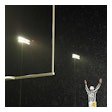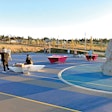![Push-button hydraulics allow for easier setup, breakdown and transportation. [Image courtesy of Gulf Coast Sports LLC in Crystal River, Fla.]](https://img.athleticbusiness.com/files/base/abmedia/all/image/2016/11/ab.Bleachers1116_feat.png?auto=format%2Ccompress&q=70&w=400)
This article appeared in the November | December issue of Athletic Business. Athletic Business is a free magazine for professionals in the athletic, fitness and recreation industry. Click here to subscribe.
On January 20, a new American president will take the oath of office on the U.S. Capitol steps before parading down Pennsylvania Avenue toward the White House — some of the time in a limousine and (if tradition holds) at least part of the time on foot. Streets will be lined with people hoping to get a look at the latest leader of the free world, and many will have their view significantly aided by a portable bleacher system.
"Our bleachers get used every four years in the presidential inaugural parade," says Chad DeBoer, national sales manager for Kay Park Recreation Corp. in Janesville, Iowa. "They use them at every intersection. It allows for quick setup and quick breakdown so traffic can return to normal very quickly."
Meanwhile, GT Grandstands, one of two mobile bleacher brands in the Chattanooga, Tenn.-based PlayCore family, counts among its clients a pig-racing venue that moves from state to state. Says GT Grandstands director of sales Brian Wilson, "The client wanted portable units to take with them across the country."
Whether watching world leaders walk or pigs run, spectators want to be able to see what's in front of them — no matter where they are — and between those widely varying examples of versatility lies the sweet spot of the mobile seating industry: institutional sports. "Schools are the main users of the bleachers," says Michelle McRae, sales manager for Century Industries in Sellersburg, Ind. "Softball fields, soccer fields. Bigger schools — especially universities — that have to have seating on the visitors' side. They're very versatile. You take them anywhere you want, as long as you have a place to open them up and spread them out."
![[Photo courtesy of Kay Park Recreation Corp.]](https://img.athleticbusiness.com/files/base/abmedia/all/image/2016/11/ab.bleachers2_sm.png?auto=format%2Ccompress&fit=max&q=70&w=400) [Photo courtesy of Kay Park Recreation Corp.]
[Photo courtesy of Kay Park Recreation Corp.]
MODELS AND OPTIONS
Mobile bleacher units come in three basic models: units that collapse flat and are physically carried, units that are tipped onto casters and moved manually, and units with pneumatic tires that are hitched to a truck or tractor and towed. Both collapsing and caster models can be as small as two or three rows (10 to 15 spectators) and lend themselves to indoor use, while the largest towable units — equipped with push-button hydraulics, as well as the electric-braking wheels and turn and brake signals that make them highway legal — can accommodate as many as 450 fans in 15 rows. Just about every size imaginable exists in between.
For the past five years, Century Industries has offered the market's largest mobile bleacher unit, with hydraulics folding all of its 15 rows and requisite safety rails in two places to form what essentially amounts to an anodized aluminum block on wheels — all in little more than two minutes. It's a $78,000 investment that's not for everyone, McRae admits, pointing out that eight- and 10-row models are bigger sellers.
At 10 rows and 45 feet long, the largest of Kay Park Recreation's Speedy Bleachers folds in half, allowing it to fit through the 8½-foot width of most overhead doors, and Century Industries' units require 13 feet of clearance, according to McRae. This allows larger mobile bleacher units to serve both outdoors and indoors, if the building — an indoor practice facility or field house, for example — has accommodating access.
But mobile bleacher variety doesn't end with size and seating capacity. Models may include such premium options as elevated seating (with steps leading up to the first row), chair-back seating and shade canopies. It may be difficult at first glance to recognize such units as anything but permanent, and indeed the temporary nature of mobile bleachers affords them little leeway in terms of International Building Codes pertaining to such elements as railings, aisles and enclosed risers.
And as codes have gotten stricter, mobile bleacher units have gotten heavier. Kay Park Recreation offers Jiffy Mover, a mobility system of wheel-lift jacks and pneumatic tires that allows one individual to safety move 10 rows of 27-foot-long bleachers weighing 575 pounds.
Even mobile seating designed solely for indoor use can provide flexibility in a number of ways, according to Ron Bilodeau, marketing and product manager at Hussey Seating Company. "Customers may want to use portable seating in multiple locations in a venue or create different layout configurations for different events, or maybe they do not have load-bearing walls to mount seating systems," Bilodeau says.
![[Photo courtesy of Century Industries]](https://img.athleticbusiness.com/files/base/abmedia/all/image/2016/11/ab.bleachers3_sm.png?auto=format%2Ccompress&fit=max&q=70&w=400) [Photo courtesy of Century Industries]
[Photo courtesy of Century Industries]
SHARED SEATING
Today's mobile bleachers are so advanced, in fact, that some schools and organizations are purchasing them to replace otherwise obsolete permanent structures. "A lot of bleachers that are older and don't comply are being taken down, and the client will call us and say they want the mobile bleachers because they can rent them out and generate revenue dollars," says McRae, adding that mobile bleachers are the only bleachers her company offers. "They're money-makers."
Century Industries even has a link on its website that provides contact information for organizations that have purchased the company's TranSport Mobile Bleachers and wish to make them available for rent. In addition, prospective renters sometimes contact McRae for leads. "If I find somebody in their area — it could be a school — I'll just give them the lead, and they can contact the owner and take it from there," she says. "We don't compete with them; we just let them do whatever they want to do to rent their bleacher out."
Sharing seating among venues, even if they are confined to the same campus, makes economic sense. DeBoer looks back to the 1980s, when Kay Park Recreation recognized the need for a mobile seating solution. "Schools' budgets were starting to tighten up, and many of the bleachers were out of code," he says. "We were able to offer a solution that only required one unit to cover multiple sports events at multiple fields or multiple locations."
Schools can also choose to concentrate mobile seating in one location, if their good fortune dictates. Says DeBoer, "It helps when they want to host playoff games that may require a certain number of seats."
Whoever succeeds in the year's ultimate contest — the presidential race — can take comfort in the existence of portable bleachers, and not only because they give enthusiastic supporters an enhanced inaugural parade experience, but for their role in helping keep terrorists and active shooters at bay. "We have a rental company that uses more than 20 of the highway-towable units to block the intersections for the inaugural parade," DeBoer says. "The security detail likes them because they discourage car bombs and prevent 'line of sight' for presidential security."
This article originally appeared in the November | December 2016 issue of Athletic Business with the title "Mobile seating offers functional, financial benefits"

































